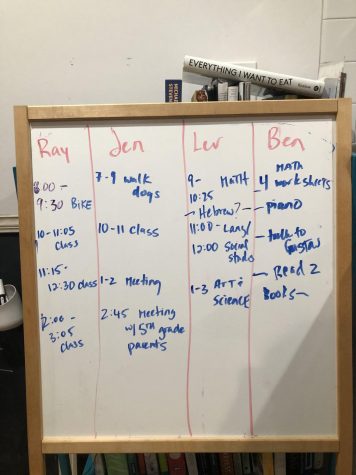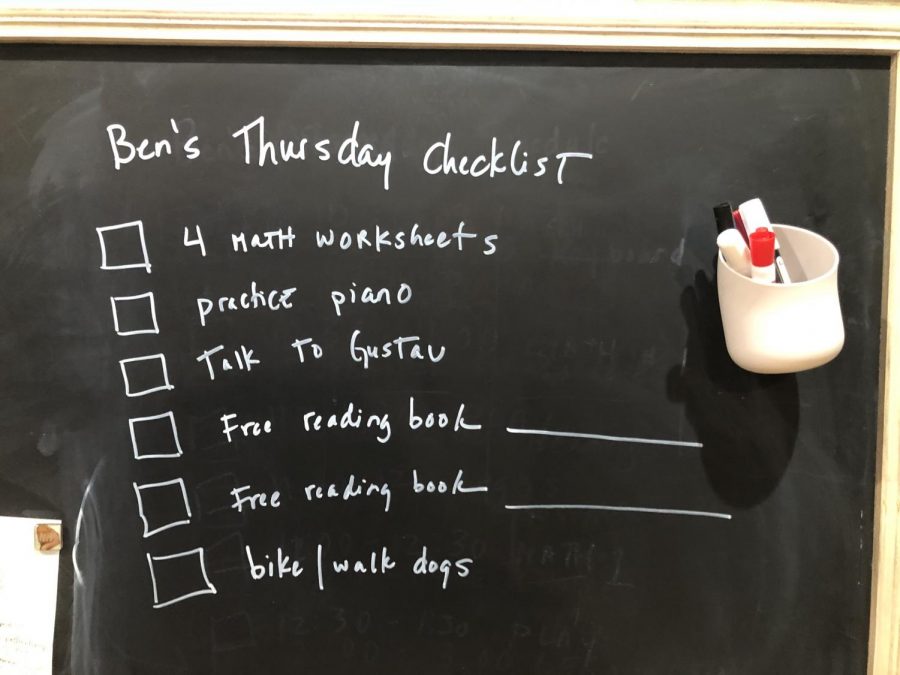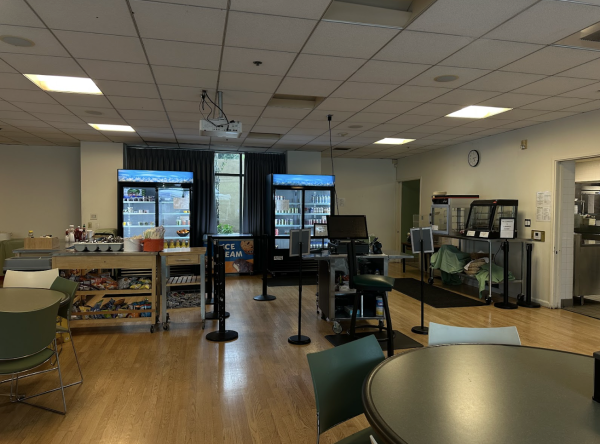With Kids Home, Teachers Balance the Double Workload
As the lines between home life and school blur, students are catching small glimpses into their teacher’s lives over Microsoft Teams. Many have watched cats climb over laptops and kids ask for help with their homework. Amid all this chaos, how are teachers coping?
Westridge teachers have already been dealing with a steep learning curve since the school shifted to remote learning and they began using Microsoft Teams and Finalsite to run their classes. But now that children are also participating in remote learning of their own, many teachers are reporting it being–to put it simply–challenging to both hold their own classes and oversee their own children’s learning. This becomes especially difficult when some parents aren’t given the resources to help their kids learn remotely.
Jennifer Golub-Marcus, Upper School History Teacher, has two sons in first and fifth grade. Her first grader attends a school in the Los Angeles Unified School District (LAUSD). “LAUSD really panicked initially, and they didn’t have any specific plan. They sent out to families about 15 websites and said to go on these websites every day. It was just overwhelming.”
For many parents, scheduling is of major concern. To help organize her sons’ learning, Marcus created a system using a chalkboard and a white board, putting each of her sons’ schedules on one or the other. But without this structure, scheduling would be a full time job. “The first couple weeks were complete madness… My little one doesn’t know how to tell time, so he couldn’t figure out what he was supposed to do. For my older one, it’s been a journey trying to get him to be more independent. He’ll be wandering around the house, and he’ll say ‘oh my gosh I have math.’ So I’m trying to figure out what I’m teaching and then help him with his schedule.”

Laura Hatchman, Upper School Science Teacher and Department chair, also found that scheduling helped her juggle her own remote learning along with her daughter, Sofie’s. “It was so fortunate that we were on spring break for the first two weeks of the stay-at-home order. That way I could focus on my family and help Sofie with school since her spring break wasn’t until the week mid-April. Once I started back up with school, however, we created a schedule to help us find routine and maintain a consistent flow to our day. That helped a lot!”
But in addition to the challenge of scheduling, parents are also having trouble motivating kids to complete their work. Dr. Jessica Bremmer, Upper School English Teacher and English Department Chair, explains that her fourth grade son isn’t finding the motivation to complete his work.
“He is a kid who really enjoys school, but I think what he enjoys so much about it is being with his teacher and being with his friends and getting to interact… so he’s hesitant and he’s resistant to the online stuff for sure. We’re doing a lot of negotiating, bargaining, and breaking things up into many chunks of time throughout the day, but it has been pretty challenging,” Bremmer remarked.
Ryan Skophammer, Upper School Science Teacher, says, “My son is doing his work, but he’s mostly likely to accomplish the tasks that are the least challenging for him. He does not enjoy watching videos or having to write, and he wants to move on to educational games on his Chromebook as quickly as possible.”
Even just finding a space to work can prove to be difficult. Skophammer has been sometimes working in his car to create a space separate from his two children. “One difficulty I have is teaching online while hearing my son struggle with his remote learning. I can hear him become audibly frustrated, and that is hard because I know my students can hear if my microphone is on, and it is distracting for me. I would love to step in and help him, but I cannot because of my responsibilities. Additionally, I have no dedicated work space or quiet space in my home and have to do a considerable amount of work in my car which is uncomfortable.”
But despite all of the obstacles facing parents, some teachers are learning from their kids’ forays into online school and are using it to inform and improve their own remote teaching. Watching her son, Bremmer recognized a couple areas she could improve for her students learning.
“The thing that has really struck me is how he’s asked to go to five or six different places to get the materials he needs… That’s really impacted my classes the most, so I’m really trying to limit how many different places I’m asking [students] to go to find what you need for class. Also, as I’m going through his work with him, I’m recognizing the things that are maybe more meaningful than others and more helpful to him than others. I’m looking at what I’m asking my classes to do and really honestly asking myself, ‘is this necessary, is this really going to help them learn this better?’”
Along with Bremmer, Marcus has been inspired by her son’s projects for school. “I feel like I want to transition to some of the more self-reflective and creative projects that he’s done, like they had to record a piece of music and put it on Flip Grid and do a scavenger hunt around the house. I see that they are more successful than whatever I’ve been doing: lecturing and marching through the research paper process.”
As teachers search for balance and order amid the chaos, they are always looking out for their students.

Sophia is the 2020-2021 Managing Editor of Spyglass and super excited to be taking on the position this year. She’s dedicated to building community,...




























![Dr. Zanita Kelly, Director of Lower and Middle School, pictured above, and the rest of Westridge Administration were instrumental to providing Westridge faculty and staff the support they needed after the Eaton fire. "[Teachers] are part of the community," said Dr. Kelly. "Just like our families and students."](https://westridgespyglass.org/wp-content/uploads/2025/03/dr.-kellyyy-1-e1748143600809.png)




























Sosi • May 1, 2020 at 1:38 pm
This is a wonderful article, Sophia!! Lots of love for you
Monica Sanchez • May 1, 2020 at 1:37 pm
Sophia, I really appreciate your article! It shines a light on the necessity to empathize with every single person with whom we come in contact. Keep up the good work!